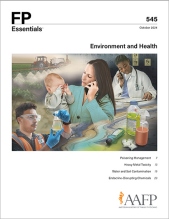
As family physicians, we provide holistic care for our patients. Since the beginning of our specialty, we have recognized the ways that families and communities affect the physical, mental, and spiritual health of our patients. It is now becoming clear that we also need to consider the health implications of the environment, not just our patient’s genetic makeup, personal actions, and interactions with the people and systems around them.
In the 1960s, multiple high-profile environmental accidents increased public awareness of the risks of toxic exposures. On June 22, 1969, the Cuyahoga River in Cleveland, Ohio, spontaneously burst into flames after years of industrial waste being dumped into the river. In response to this environmental disaster and press coverage of it, President Richard Nixon proposed a comprehensive program to address pollution and study the effects of contaminants on the environment in 1970.1 This led to establishment of the Environmental Protection Agency (EPA), increased community awareness about the effects of pollution, and advancement of the scientific study of toxicology, environmental exposures, and occupational health.
For most patients, their family physician is their first point of contact with the health care system. Much of the time, identification of potential toxic exposures, initial testing and diagnosis, and patient education and risk reduction fall to primary care practices. Identification of toxic exposures is complicated. Determining the causative agent often involves awareness of group vulnerability and exposure risk as well as individual risk related to the location of the patient’s home, hobbies, or occupation. Family physicians should work with health departments and poison control centers to address individual patient exposures as well as public health concerns within the community. Physicians also need to be aware of reporting requirements for toxic exposures in their local jurisdictions.
This edition of FP Essentials addresses what family physicians need to know about the environment and health. Section One examines the roles of poison control centers, health departments, and family physicians in addressing toxic exposures. Section Two discusses heavy metal toxicity, including potential sources of exposure, symptoms of toxicity, and treatment of exposed patients. Section Three explores the causes and effects of water and soil contamination. Section Four reviews various endocrine-disrupting chemicals and their effects on health.
Although most of us received limited information about toxic substances as part of our medical education, we now encounter questions about exposures and their consequences for patient health on a regular basis. The information in this monograph will allow you to better guide your patients in this complex arena.
Ryan D. Kauffman, MD, FAAFP, CCFP, Associate Medical Editor
Family Medicine Physician
Erie Shores Family Health Team, Leamington, Ontario, Canada

